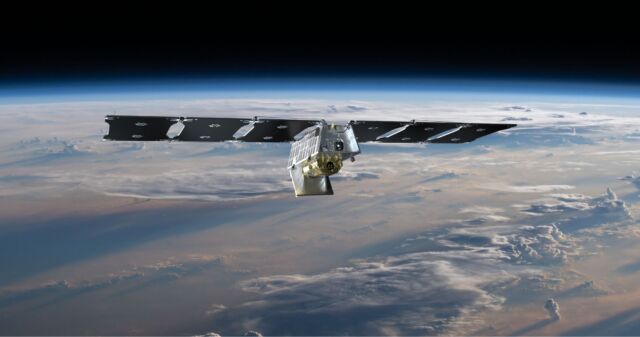
Space is more accessible than ever before thanks to the proliferation of small satellites and increasingly affordable launch prices. This has given rise to tailored applications such as global pollution monitoring, crop observations, and new ways to collect weather and climate data.
Now you can add wildfire detection to the list. Satellites have been monitoring wildfires from space for decades, but a new initiative funded in part by Google’s philanthropic arm aims to deploy more than 50 small satellites into low-Earth orbit to pinpoint flames as small as a classroom, anywhere in the world.
The FireSat constellation, managed by a nonprofit called the Earth Fire Alliance (EFA), will be the first fleet of satellites dedicated to detecting and tracking wildfires. Google on Monday announced a new $13 million investment in the FireSat constellation, building on the tech giant’s previous contributions to support the development of custom infrared sensors for the FireSat satellites.
Google's financial commitment will maintain the schedule for the launch of the first FireSat Pathfinder satellite next year, EFA said. The first batch of satellites forming an operational constellation could be launched in 2026.
“Today’s announcement marks a significant milestone and step toward transforming the way we manage fire,” Earth Fire Alliance said in a statement. “As fires become more intense and spread faster, we believe radical collaboration is key to driving much-needed innovation in fire management and climate action.”
A new use case
The FireSat satellites are being built by Muon Space, a California-based satellite manufacturer. Each of the microsatellites built by Muon Space will carry six-band multispectral infrared instruments that will monitor a swath of the Earth about 900 miles (1,500 kilometers) wide to locate wildfire hotspots.
The satellites will have the sensitivity to find wildfires as small as 16 feet by 16 feet (5 meters by 5 meters). The network will use Google AI to quickly compare observations of any area of this size with previous imagery to determine whether a fire is present, Google said. AI will also factor in factors such as nearby infrastructure and local weather in each fire assessment.
Google said it had validated its detection model for smaller fires and established a baseline dataset for the AI by flying sensors over controlled fires. FireSat’s partners announced the constellation in May after five years of development. The Environmental Defense Fund, the Moore Foundation and the Minderoo Foundation also support the FireSat program.
After detecting a wildfire, it is crucial for FireSat to quickly communicate the location and extent of a fire to emergency responders. With the first three satellites, the FireSat constellation will observe every point on Earth at least twice a day. “At full capacity with 50+ satellites, return times are improved to 20 minutes for most of the world, with the most fire-prone regions benefiting from sampling intervals as short as nine minutes,” Muon Space said in a statement.

Muon space
NASA operates a fire detection system that uses satellite observations from the agency's Earth-observing missions, but none offers the sensitivity, resolution or response time of FireSat. More than 200 commercial Earth-imaging satellites owned by Planet provide new images of nearly every land mass on Earth every day. These satellites can also detect wildfires, but the imagers on Planet's spacecraft have a narrower field of view than FireSat's.
The list of nonprofits and philanthropic backers of the FireSat constellation is similar to the group of foundations that funded MethaneSAT, which launched earlier this year. MethaneSAT, as its name suggests, monitors methane emissions from space, and the project was funded primarily by private contributions. Google is also a partner in MethaneSAT, where it is integrating AI technology into the data analysis and making the data accessible using Google Earth.
All of this has been made possible by lower barriers to entry into space for small businesses, research institutions, and philanthropic enterprises. There is more private investment in satellite manufacturing companies than in any other sector of the space market, including launches. The proliferation of satellite manufacturers has made it more affordable to buy a spacecraft or a fleet of satellites.
And it’s cheaper to put a satellite into orbit. SpaceX charges $1 million to launch a payload of about 366 pounds (166 kilograms) on one of its Transporter rideshare missions on a Falcon 9 rocket, significantly less than any other launch company. MethaneSAT launched earlier this year on a Transporter rideshare mission, and while officials have yet to announce a launch provider for FireSat, SpaceX is the company to beat.

